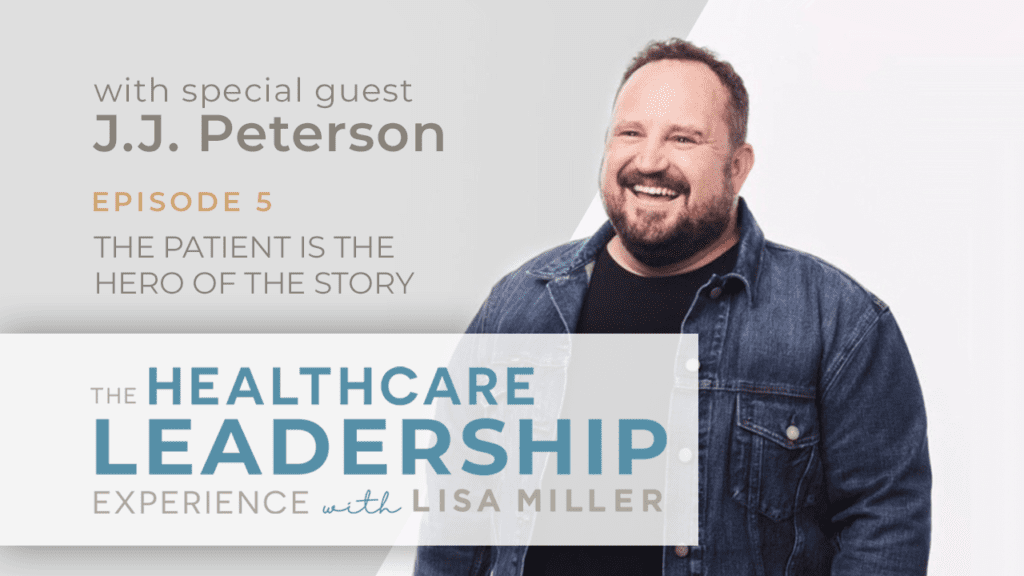In our fifth podcast, Lisa is joined by Dr. J.J. Peterson, Chief of Teaching and Facilitation, StoryBrand and together, they explore how the patient is always the hero of the story.
J.J. is the co-author of Marketing Made Simple, A Step-By-Step Marketing Plan for Any Business. As he observes, “…hospitals have these amazing stories of people who have .. benefited from your services. And literally .. lives have been saved.”
This episode is sponsored by VIE Healthcare who has proudly helped hospitals save over $1 Billion since 1999.
In this episode you’ll hear:
- How to think differently about your messaging to patients and position them as the hero in your story. “Good storytelling is about inviting people into a story and…. living out an epic journey of transformation.”
- How applying the principles of Storybrand transformed the recruitment program at Orange County Children’s Hospital.
- Why narrative transportation, or telling a good story, is the key to more buy-in from your patients and employees (and why stories don’t work when you break the rules).
- The seven elements essential to creating a cohesive story and engage with your target audience via examples from Jason Bourne, The Hunger Games and Star Wars (hint: don’t allow your hospital to make the same mistake as Sleepless in Seattle).
- Why your health system needs to be Obi-Wan Kenobi to your patients’ Luke Skywalker to create more engagement. “The big paradigm shift is you need to be the guide in the story.”
- The reasons a clear three-step process is the way for healthcare organizations to attract new patients and people who want to do business with you.
- How applying the Storybrand framework can transform your health system’s marketing success so that patients “in their moment of crisis don’t have to worry about anything but getting through the door.”
CLICK HERE TO DOWNLOAD THE PDF TRANSCRIPT
Resources:
🖥 https://storybrand.com
Connect with Lisa:
🖥 https://viehealthcare.com
📱https://www.linkedin.com/in/lisamiller/
Check out this episodes sponsor:
🖥 https://isugezt.com
CLICK HERE TO OPEN THE FULL TRANSCRIPT
Lisa Miller (00:04):
So welcome Dr. J.J. Peterson to the Healthcare Leadership Experience. I’m so excited.
J.J. Peterson (00:14):
I’m excited to be here too. Thank you so much for having me.
Lisa Miller (00:15):
That’s great. So I want to jump right in because there’s a lot to talk about — but before we do, can you share with our listeners who you are, what you do, talk about StoryBrand.
J.J. Peterson (00:26):
Yeah. So StoryBrand really is a company that helps people with their marketing and messaging. So a lot of companies really have confusing messaging and they don’t even know it. They’re so close to their products and services that their websites, their emails, the way they pitch their organization is actually really confusing messaging because they’re just so close to their products, they don’t understand how to communicate it well. And what we do is we come in and we help companies organize their message, create a clear message, and then put that message into their marketing and branding. So their websites, their emails, their lead generators, sales pitches, donor pitches, all of that stuff. And one of the big problems with the way people are creating messaging is that they’re telling the wrong stories. So obviously, when you work in the medical space — in hospitals in particular — you have these amazing stories of people who have come through and benefited through your services. And literally lives that have been saved
J.J. Peterson (01:31):
There are almost no better stories than what hospitals can tell, right? Because they’re a part of saving and changing lives on a regular basis. But even though those are great stories, you can screw up the way you tell those stories in your marketing and messaging, because — here’s the big thing, is that most companies position themselves as the hero in the story. They want to say how great they are. They want to talk about how wonderful their services or state-of-the-art services are. But the reality is you need to be positioning your customer as the hero of the story, right? And your customer can be really anybody. It can be a parent bringing a child in. It can be a specific patient. It can be a doctor that you’re trying to partner with, the practice you’re trying to partner with. It can be donors that you’re trying to get on board. Whoever your audience is, you need to position them as the hero in the story.
J.J. Peterson (02:24):
And when you position them as the hero in this story, then you need to position yourself as what we call the Guide. And so you are the Obi-Wan Kenobi to their Luke Skywalker, right? And you need to tell a story that invites the customer to be the hero. And there’s very specific ways to do that. There are rules to how you tell story. And those rules go all the way back to Aristotle and Plato really — like they were the ones who really defined how to tell a good story. And those rules have been refined over the years, even today, they’re getting refined at the box office, or on Netflix — will a story work or will it not in a movie?
J.J. Peterson (03:08):
Well, most of the time when a story doesn’t work, it’s because they’ve broken the rules. And it’s the same thing with your marketing and messaging. If you’re breaking the rules of storytelling, then you’re missing out on incredible opportunities that, not only will grow your own practice and business, but ultimately prevent people from getting the life-saving help that they need.
Lisa Miller (03:30):
I want to let everybody know that you have worked with my confusing message to help make it clear — and it was spectacular work. And it was so helpful and it really changed the way we market and we have our discussions with hospitals. But I want to jump right in, your Wall Street Journal, best-selling author Don Miller, it’s called Marketing Made Simple?
J.J. Peterson (03:59):
Yes.
Lisa Miller (04:00):
Everybody read it, re-read it, it’s an amazing book. The book opens with, Don’t Waste Your Money on Marketing That Doesn’t Work, big bold letters.
J.J. Peterson (04:14):
Yeah. I’m very passionate about that.
Lisa Miller (04:15):
So I wanted to hear your work with the hospital. We got a chance to talk a little bit about it, but I’m excited to hear your work with the StoryBrand and brands crippling with the hospital and really taking that process through the whole organization.
J.J. Peterson (04:33):
Yeah, so I get to work with really thousands of companies every year. We do online training. We do live stream workshops where people can come and be coached through the process. And then we also do private workshops where we go and work with companies individually. And I got to, this number of years ago, work with Lululemon, the baby carrier, and so I got to learn a whole bunch of different things about… I learned more words about hip dysplasia and things like that that I never knew. And I had a lovely time working with Lululemon and doing their marketing and the head of marketing at Lululemon then went and worked with Orange County Children’s Hospital. And we became good friends through that process. And when she went to Orange County Children’s Hospital ended up bringing me in to work with them over multiple days to do some private workshops.
J.J. Peterson (05:29):
So I came in and worked with their entire staff and then also worked with separate departments. So had a big workshop where we took everybody in marketing and branding, and anybody who did customer-facing websites or language or meetings — and met with all of them and then spent the next couple of days breaking down individual departments. So I got to work with the people who work with their major donors. The people who specifically target doctors to build relationships with. How to brand-script parents and how to create those stories. And then also worked with their HR department to talk about how they recruit and do training for new employees. And they came up with… This was not me but they took the StoryBrand principles and they actually created this unbelievable program where when people come in to begin working with them, they make them the hero.
J.J. Peterson (06:28):
So they are the audience, right? So they’re the audience that they’re trying to recruit and join this team. And they ended up saying that when you join Orange County Children’s Hospital, you are joining a mighty brigade. And they really had to put that as an identity on the people who are coming. So you are part of the mighty brigade who is a defender of childhood. And I’m actually getting goosebumps now even thinking about it. And they made up this pledge that everybody signed. And normally when you create a pledge for employees to sign, it’s like grudgingly and they were having people come to them and go like, when do I sign? Where do I sign? And you signed that you joined the mighty brigade and became a defender of childhood. And they created that messaging out of the StoryBrand framework.
J.J. Peterson (07:17):
So the StoryBrand framework again, creates your audience, your customer, is the hero. So you won’t even be thinking about how do you position your employees as the hero of the story, right? And so they get to be defenders of childhood, or they get to be the people who are bringing life and health. And it’s not just for the doctors and nurses, that goes down to the janitor, the bookkeepers — everybody gets to be a part of that. And when you can invite people in, that’s what really good storytelling is about. Good storytelling is about inviting people into a story. And when I can see myself living out this epic journey of transformation, I want to be a part of that. And if you as a hospital then position yourself as the Guide. So saying, ultimately, look, hey, we know that you don’t want to just sweep floors, you want to be a part of something bigger. You want to be a part of defending childhood, giving kids back their childhood. We know this. And so we’re going to help you do that.
J.J. Peterson (08:20):
That’s what positioning you as the Guide is saying, I’m going to come in and position myself as the Guide to help you become a defender of childhood. And the way that story works… Well, let me finish the thought. I see I can go everywhere with everything, but ultimately, what you’re doing is you’re going to get more engagement. You’re going to get more buy-in and ultimately, you’re going to get more people, and specifically to use your product and services. That was an example of how to do it internally, but really when you are doing this in your emails and your website and your sales pitches or donor pitches — what you’re doing is you’re going to get more engagement.
J.J. Peterson (09:00):
So from a… I’ll use a little bit of my education here at my communication, Ph.D., is… there’s a thing called narrative transportation. Narrative transportation is when you transport yourself as a viewer or a consumer of a story, transport yourself into the story. So if you’ve ever used the phrase, I got lost in a book, or when you’re watching a movie and something scary happens and you jumped, or people kiss at the end and you cry. You are technically transporting yourself into that story. You see yourself in that story. The better the story, the more likely narrative transportation is going to occur. Now, that’s one piece, so you have to tell a good story in order for narrative transportation to occur. Once narrative transportation occurs, the higher level of narrative transportation you experience, the more likely your mind and your actions are to be changed.
J.J. Peterson (10:05):
So the better the story, the more likely you are to engage in the story, see yourself in the story, the more likely it is going to have an impact on you, right? So that’s how story works. And that is true for movies and books — but it’s also true for marketing. When you tell a good story or invite people into good story the right way, the more likely they are to see themselves in that story. And then the more likely they are to be moved by that story — both their heart, like their mind and their actions, so they’re more likely to buy. But the problem is, if you break the rules of story, people won’t experience narrative transportation. They start thinking about the story instead of being in the story.
J.J. Peterson (10:50):
So a movie example of that would be like if you’re watching… This is true. You’re watching Sleepless in Seattle. And in Sleepless in Seattle, they’re going across a bridge that if you’ve ever been to Seattle you know the bridge doesn’t go to where they end up in the movie, right? So they show them on one Island and then they go on this bridge and then they show them somewhere else and you’re like that bridge doesn’t go there. Well, you broke a rule of story. So I actually stop watching the movie and being in the movie. And I start thinking about the fact that they broke a rule. That bridge doesn’t go there, which means the story is not cohesive. It doesn’t stick together. So in order for a story to be good, you have to tell a cohesive story. So at StoryBrand, what we’ve done is create a framework or basically, boiled all the rules of story down to seven elements.
J.J. Peterson (11:44):
You have to have seven elements in every story for it to be cohesive. When a story is cohesive and has fidelity — so sticks together and makes sense, people experience narrative transportation. They’re more likely to buy your product. So the seven elements of a good story are, that in every good story, you have to have a character. That you immediately have a character in some cases, it’s a group protagonist, but there is basically usually one main character who wants something. And that has to be very, very clear. The character can’t want 20 things they have to want one thing. So Jason Bourne wants to know who he is, what his history is, but he can’t also in the movie, want to open a bakery, run a marathon, adopt a cat. That makes a horrible story, right? Because there’s just too much going on. So the character has to want one thing. If you do too many things, it breaks the rule.
J.J. Peterson (12:45):
That’s the first step. The second is the character has to experience a problem. There has to be a problem that gets in the way of what the character wants. And that is really the crux of the story. A story only gets good when there is a problem. If Jason Bourne was just on a beach and had no problems, that’s a very boring two-hour movie, right? Of just someone just sitting there enjoying the sun and the sea. There has to be a problem that hooks the audience and goes,” is he going to overcome that problem?” Then the character meets a Guide, somebody who comes alongside. We know that that character cannot solve the problem themselves. So they have to meet a Guide. Somebody who has been there and done that. Who has established more authority in that space and overcome the same problem that they have.
J.J. Peterson (13:35):
So like in Hunger Games, Katniss is the hero. Haymitch is the guide because he has won the Hunger Games. In Star Wars, Luke Skywalker is a character. Obi-Wan Kenobi, Yoda, they’re the guides. They’ve already become jeopardized. They know what it’s like. So that’s step three. Then in element number four in a good story is the Guide has to give the hero a plan. So they have to give them a way to overcome the problem. Has to be simple. It has to be easy, has to be clear and show that the end goal is achievable. Then there is a moment in the movie or story when the character is called to action. That they have to accept or reject something. They have to say, I’m going to move forward and risk everything by trying to destroy this bomb that’s going off in five minutes or I’m going to run the other way.
J.J. Peterson (14:29):
There’s a moment they are called to action, they must accept or reject this thing that they have to do in order to overcome all the problems and everything. And then we know their stakes in the story. So this could go really, really well and there could be a happy ending of success where they get the girl, they live happily thereafter — or there is failure and everybody dies, right? So we know that those two things can happen. So those are the seven elements of story. A character who wants something, who experiences a problem, who meets a Guide, who gives them a plan, calls them to action. And we know that this can end in success and failure. That’s it. That’s every movie you’ve ever seen. That’s every story you’ve ever seen.
J.J. Peterson (15:14):
Well, when it comes to marketing, now, so if we take those same principles and apply them to marketing, what we start with is we have to understand that the hero of the story is your customer. They are the main character, and we need to identify what it is that that customer wants. And it needs to be very clear. So we need to establish and put that in our marketing right off the bat, not confuse anybody. When you come to us, this is what you get, because that’s what they want, right? So we establish what the character wants. Then we have to establish what is the problem that is getting in the way for that character. And we need to talk about that in our marketing over and over and over again. The only reason somebody is coming to you is to solve a problem. So if you’re not articulating how you solve that problem for people in your marketing, you’re missing out, you’re not telling a good story. And like I said, that’s what makes it a good story. That’s what hooks the reader or the character, is the problem.
J.J. Peterson (16:13):
So you need to be talking about it over and over. Then the big paradigm shift is you need to be the guide in the story. You are the guide, not the hero. So the only way you talk about yourself is with empathy and authority. So I understand what you’re going through. I’ve been there. We’ve been there. We get your pain, but also we’ve solved the problem for other people. That’s it. In your bio, even as for doctors or even hospital management, if you’re talking about the fact that you won the three point contest in high school or your favorite ice cream flavor is chocolate, that has no empathy or authority over your customer’s problem.
J.J. Peterson (16:59):
My child is sick and you’re telling me the way you’re going to help me is that your favorite ice cream is chocolate, that doesn’t associate with me. If you say, like you, I am a parent who also has had to deal with sick kids. And I know how frustrating and hard that can be to navigate medical bills while your child is injured or sick. Now that’s empathy. I don’t care that you’re a yoga instructor. I don’t care that you’ve been to seven continents. It doesn’t-
Lisa Miller (17:31):
A marathon runner.
J.J. Peterson (17:33):
Yeah. It doesn’t matter because that’s your story — that makes you the hero of the story. If I’m the hero of the story, then the only reason you’re in my story is to be the guide. That’s it. So you only have empathy and authority for my problems. That’s it, in marketing. Now as a real person, it’s a whole other thing, but in marketing, that’s all you talk about. And that’s a huge mistake people make. Secondly, and granted like obviously if you’re running a state-of-the-art facility that has new technology and the best doctors in the world, that’s authority. So that’s fine because it deals with my problem and you can solve my problem. So don’t feel like you can never talk about yourself. You can only talk about yourself in relationship to overcoming my problem.
J.J. Peterson (18:20):
Then you need to give your customer a plan. A clear three-step process to do business with you. This was really huge when it came to working specifically with doctors who are working with patients. A lot of times when somebody gives a diagnosis or a treatment plan, you give all the options that are going to happen. You give all the different things that they’re going to do for you. And what we feel like that is, is giving people the… If I give you the 20 different things I’m going to do in the background in order to make sure that you’re okay, what I’m doing is communicating value. I’m showing you I’m being thorough. I’m showing you I’m doing my job. I’m taking care of everything. When you do that, it actually confuses people because there’s a whole science behind how people process information and that your brain is actually burning calories and having to think, and our brain is designed to conserve calories.
J.J. Peterson (19:24):
So it actually will tune you out if you are not making… If I have to think too hard, my brain is literally designed to tune you out so that I can maintain the calories I need to make better decisions later if a tiger jumps out at me, right? It’s really like, I need to stay alive. And what you’re communicating to me, you think is telling me, this is how I stay alive. But the reality is too confusing. So I’m tuning you out. So you need to give a clear, simple plan in everything — of how to check-in, how to donate, how to come to the hospital, how to choose your doctor. And specifically for doctors, what is the treatment plan?
J.J. Peterson (20:05):
I don’t care if there’s 20 steps in the treatment plan, give them three. Here’s what we’re going to do. First, we do this. Second we do this. Third we do this. You have to keep it simple and clear. If you don’t keep it simple and clear, then that makes a story about you because you’re trying to show how great you are, how smart you are but if you want to make it about your customer, about your patient, it needs to be a three-step plan. That’s it. That’s again, how our brain works.
J.J. Peterson (20:29):
Then there needs to be a very clear Call To Action. What is the next step I’m supposed to take in order to win the day? So essentially, buy now, come in now, start a treatment plan, you want something that’s very clear, not learn more. Learn more as not something I accept or reject as far as doing business with you, give me something I can accept or reject. And then you have to paint a picture of success and failure. So you have to tell me in your marketing and messaging, what my life will look like if I do business with you and what things I will miss out on failure if I don’t do business with you.
J.J. Peterson (21:07):
Those are the seven elements of a good story in a movie. And those are the seven elements in your marketing that you need to create in your messaging. Once you do those, then you can place those on websites and emails. It can be about sales sequence. It can be about donor meetings, all of that stuff, hiring new employees. You were able to take that messaging and tell a better story that engages more people, that they can see themselves in the story. So they experience narrative transportation, which therefore ends up allowing them to influence the… You can influence their mind and their actions.
Lisa Miller (21:42):
J.J, I just want to thank you. What a bonus you just gave our listeners, you-
J.J. Peterson (21:49):
I know I just talked a lot. So hopefully-
Lisa Miller (21:50):
No, I’m so glad you did, because I’ve been to the workshop twice and there’s so much in the workshop. So what you’ve given our listeners is such a bonus. I just want to thank you for going through that. I was not expecting that. It’s fabulous.
J.J. Peterson (22:06):
Oh, good.
Lisa Miller (22:08):
So it sounds easy and it’s not. Just for everybody listening, it is not easy to do. So I want to mention a couple of things. You can go to storybrand.com. And I know that there’s a virtual workshop and ways to work with you, and it is not easy. But I will tell you when you come out the other end and do the hard work, you come up with a message like you spoke about with the children’s hospital. You come out with this great messaging that you can use in so many places. So I found it fascinating about culture. You take that message. You can bring it into your culture, happy employees, happy patients.
J.J. Peterson (22:51):
Yeah, 100%. Yeah. I use it with my own employees. Even just when we’re sitting down and setting goals and visions, it’s like, all right, who do you want to be? What if the problems get in the way of that? How can I help you? What’s our plan? What are the deadlines? And what’s life going to look like when it’s over? You just start thinking in those terms, and like you said, it’s not easy. It does take some work, but I really genuinely think that anything that is worth it does, right?
J.J. Peterson (23:17):
And so like what you were saying, when you come to a live workshop, you spend two days with us. It’s not a short thing, you go two days, you have a coach that actually works through the process with you, or same thing if we do a private workshop and come and work with your whole team, then we have somebody that comes and works with you for a day and a half — just with your team. But by the end of it, you have a clear message on one piece of paper and you’re not wasting time figuring out how am I going to say what we want to say? How do I get more people engaged? How do I tell a clear message? You just do that and it saves you, I think honestly, years of work.
Lisa Miller (23:53):
I would agree with you. So I was on your LinkedIn page. I just wanted to get a little more prepared, even though I know you and I loved your bio and I’m going to read it because… Or the section, right? It just says, “Most business leaders struggle to talk about what they do. At StoryBrand we’ve created a communication framework that helps people clarify their message so the business starts growing again.” And then it says, “We help you clarify your message at storybrand.com.” To me, I could envision hospitals coming up with a framework on three sentences just like that to explain to their community or patients what they do.
J.J. Peterson (24:30):
Yeah. We call that a one-liner and we actually teach that at the workshop because what it is, it’s a short story. It’s not the full story, but whenever you describe what you do. Yeah, that’s my LinkedIn bio, right? So I don’t say my name’s J.J Peterson. I’m chief of teaching and facilitation at StoryBrand and we help companies clarify their message. That’s like the common, right? It talks about me. That’s my story but my bio is your story, right? I talk about your problem. A one-liner is three parts, problem, solution success. And it’s the customer, the problem they’re experiencing, the solution you offer for the customer and what success looks like for your customer. So that’s a short story and it gets people to see themselves. It’s like, if I was to say, and this is another thing is a lot of people go, so what do you do? And they go, well, it’s complicated. And what have you just told me? I’m not going to be able to understand. I’m going to have to burn too many calories. So I’m tuning you out already.
J.J. Peterson (25:37):
But the other thing is if you just say, well, I’m actually a hospital administrator and this year we grew a lot and we helped a lot of… That’s your story. But if you started that by saying, a lot of people really struggled to navigate the healthcare system because it’s hard to work with insurance companies and take care of your family at the same time. At St. Bonaventure, we make navigating hospital and insurance easy and put the patient’s care first — so that they can get the life that they want, live as healthy as they want and not have to worry about getting in trouble with insurance companies. Problems-Solution-Success, right? So you don’t talk about you, you talk about them. Then that easily goes, tell me more. Oh, my gosh, I love that idea, right? Because that story is about the person you’re addressing. So that’s just a very simple thing that we do, but it’s a short story and you learn how to do that at our live workshop.
Lisa Miller (26:40):
Yeah. And I want to say it’s not an enormously difficult process. What I’m saying is that it requires work, right? You hear you talking this through anything, well, I can do that, but really requires you roll up your sleeves to know what the hero, the three-step plan and understand that journey. And like you said, when you come out of it, you really have this framework that’s about your customer or the patient and where they can feel like, oh, they understand me and I can get help.
J.J. Peterson (27:16):
And here’s just one last thing that I’d love to say, because why I’m very passionate about this and I want to come on here and talk about it is because, if you’re making your messaging confusing and you literally have the tools to save people’s lives, it is your responsibility to do the work so that your customer doesn’t have to. That’s really what it comes down to. If you have the ability to help them overcome these tremendously hard problems, right? Not only just physical, but emotional and financial, and you have the ability to do it, but you’re making your messaging so confusing or all about you, that people are tuning it out and moving away from you — that’s a problem for me. I want hospitals that are doing good work to be able to communicate so clearly that patients in their moment of crisis don’t have to worry about anything but getting in the door.
J.J. Peterson (28:14):
And when you create good websites and emails and sales pitches and all that stuff, you’re doing the work for your customer. It is a service to them. So when you put in this work of clarifying your message, you are serving them. It’s not just like, oh, we’re going to make more money, which you will, but it literally is serving them so that in their moment of crisis, you have the ability to step-up and be the guide — not just about making the sale — but literally about helping them become and live who they want to be and live the life they want to live. I genuinely think this is a way to serve people that goes beyond just the medical help that you’re offering.
Lisa Miller (28:54):
So I have nothing further to say, I think you said that brilliantly, J.J. It’s true the hospitals have a service and they’re doing lifesaving work. Their messaging should reflect that. So I’m going to leave it there. I think it was beautifully said. Thank you so much for being on our show. And I want everyone to know how to reach you. What’s the best way to reach you. I know it’s storybrand.com but is it the best way to reach you?
J.J. Peterson (29:22):
Yeah, storybrand.com is the best way. And we’d love to see people at one of our events and help out any way we can.
Lisa Miller (29:30):
Yeah. And like I said, I’ve been to the event twice and I will absolutely be at the event again in 2021, and please pick up your book, Marketing Made Simple. Thank you very much, Dr. J.J. Peterson. I appreciate you being on the show.
J.J. Peterson (29:45):
Thanks for having me.











